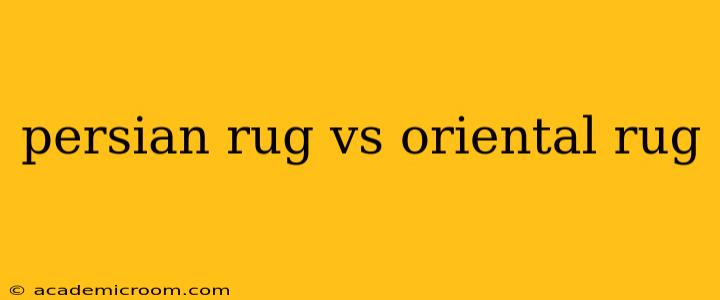The terms "Persian rug" and "Oriental rug" are often used interchangeably, leading to confusion among rug enthusiasts and buyers. While seemingly synonymous, there's a crucial distinction. Understanding this difference is key to appreciating the artistry and history behind these exquisite floor coverings. This guide will clarify the nuances between Persian and Oriental rugs, helping you navigate the world of antique and contemporary rugs with confidence.
What is an Oriental Rug?
The term "Oriental rug" is a broad category encompassing hand-knotted rugs originating from the Orient—a historical term referring to the countries of Asia. This includes a vast array of styles, patterns, and weaving techniques from various regions, including:
- Persian rugs: These are rugs made in Persia (modern-day Iran).
- Turkish rugs: Known for their intricate geometric designs and vibrant colors.
- Caucasian rugs: Characterized by bold patterns and often featuring intricate medallions.
- Indian rugs: Showcasing a diverse range of styles influenced by Persian, Turkish, and local traditions.
- Chinese rugs: Frequently featuring landscapes, dragons, and other symbolic motifs.
- Pakistani rugs: Known for their intricate designs and use of high-quality materials.
Essentially, an Oriental rug is an umbrella term; a Persian rug is a specific type of Oriental rug.
What is a Persian Rug?
A Persian rug, as mentioned, specifically refers to a hand-knotted rug crafted in Persia (Iran). These rugs are renowned for their:
- Exceptional craftsmanship: Persian rug weaving is a highly skilled art passed down through generations. The knotting techniques, the meticulous attention to detail, and the quality of materials are hallmarks of these rugs.
- Diverse designs and patterns: From intricate floral motifs to geometric designs and medallion patterns, Persian rugs showcase a vast array of artistic styles reflecting the rich cultural heritage of Iran. Specific regional styles, like those from Tabriz, Kashan, or Nain, are highly sought after by collectors.
- High-quality materials: Traditionally, Persian rugs are made from fine wool, silk, or a blend of both. The quality of the materials contributes significantly to the rugs' durability, softness, and overall aesthetic appeal.
What are the Key Differences Between Persian and Oriental Rugs?
The core difference lies in specificity. Oriental rug is a general term encompassing rugs from various Asian countries. A Persian rug is a subset of Oriental rugs, specifically those originating from Iran. Thinking of it as a Venn diagram, Persian rugs fall entirely within the larger category of Oriental rugs.
Are All Oriental Rugs Persian Rugs?
No. As explained above, Oriental rugs encompass a much wider geographical area and stylistic range than Persian rugs. While Persian rugs are highly regarded as some of the finest examples of Oriental rugs, other regions like Turkey, India, and China have also produced exceptional hand-knotted rugs with distinct characteristics.
What Makes a Persian Rug Valuable?
Several factors contribute to the value of a Persian rug:
- Age and history: Older rugs, especially those with documented provenance, are often more valuable.
- Materials: Rugs made from fine wool, silk, or a blend of both tend to be more highly prized.
- Knot density: A higher knot density indicates greater craftsmanship and detail.
- Design and artistry: Unique and intricate designs, reflecting specific regional styles or master weaver's skills, increase value.
- Condition: Well-preserved rugs in excellent condition are naturally worth more.
How Can I Tell if a Rug is Truly Persian?
Authenticating a Persian rug can be challenging. Look for:
- Certificate of Authenticity: While not foolproof, a certificate from a reputable dealer can provide some assurance.
- Expert appraisal: A qualified rug expert can examine the rug for details like knot type, materials, and design elements to determine its authenticity and origin.
- Weaving techniques: Certain knotting techniques are specific to particular regions of Persia.
By understanding the distinction between Persian and Oriental rugs, you can appreciate the unique artistry and craftsmanship involved in their creation. Whether you're seeking a traditional Persian rug or a piece from another region of the Orient, careful research and potentially seeking professional advice can ensure you make an informed and satisfying purchase.
